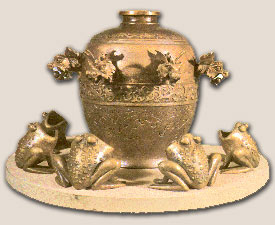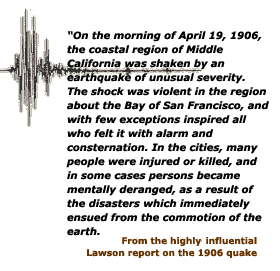
|
Science from the Ashes
The 1906 earthquake did more than shake up northern California, it also jolted geologists into focusing on how and why faults break loose. It was the decisive action of a dedicated group of scientists that would make that violent 300-mile (480 km) rupture of the San Andreas Fault one of the most carefully studied and thoroughly documented earthquakes in the United States. The report that these pioneering geologists produced has become a bedrock of our current understanding of earthquake hazards and seismology and is widely admired as a model scientific study. Its vivid, clear prose, attention to scientific detail, thoroughness and accuracy, and numerous photographs, maps, and diagrams make it a relevant and fascinating read to this day. Seismology was a relatively new field of scientific research in 1906, with work up to that time having been done largely in Europe and Japan. With its history of frequent, devastating earthquakes, Japan established the first organization dedicated to the study of seismology, the Seismological Society of Japan, in 1880. English geologists, working in collaboration with their Japanese counterparts, performed the first comprehensive studies of how seismic waves propagate during earthquakes. These studies depended on the newly invented modern seismograph, which produces the familiar heartbeat trace of ground motion. (The first device to record ground motion was invented around AD 132 in China.) By the mid-1870s, seismographs had been placed in arrays throughout Europe, Asia, Africa, Australia, and North and South America to record the magnitude and frequency of earthquakes all over the world. Earthquake research in the United States was proceeding at a slow pace, however, and relatively little was known about how and where earthquakes occurred in the rapidly expanding west. Almost immediately after the events of April 1906, Scottish-born geologist Andrew Lawson realized that a comprehensive scientific study of the earthquake needed to be swiftly organized. Lawson was head of the geology department at the University of California in Berkeley and a well-known and respected scientist. His research included some of the first geologic maps of northern California, and he gave the San Andreas Fault its name before the fault became infamous for causing one of the nation’s largest urban disasters. Lawson convinced the governor of California to establish and appoint the State Earthquake Investigation Commission (SEIC), and he was elected its first chairman. From this group, the Seismological Society of America was formed in November 1906 with Lawson as one of its first officers. The Berkeley geologist coordinated and edited the 451-page volume 1 of the SEIC’s report of the earthquake, published in 1908, which became known as the Lawson report or the 1906 report. (A colleague of Lawson’s, H. F. Reid, edited the 192-page volume 2 of the report, which came out in 1910.) Research on the earthquake was organized into three main studies and divided among the commission’s geologists, astronomers, mathematicians, and meteorologists. One group documented surface changes associated with the earthquake and collected data on the intensity at different places. The second group compiled arrival times of earthquake shocks along the fault. A third group took information from the first two studies and started to work out the geophysics of the earthquake. |
Live Eye • Great Shakes • Quake Basics • Damage Control • Active Zone



